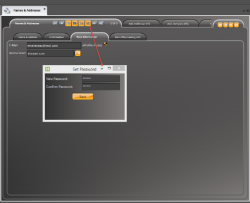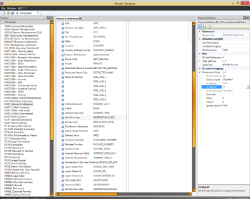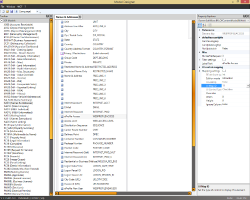201-ar-bp-033
201-ar-bp-034
201-ar-bp-034 #AccountsReceivable #arall #arbp #AR #egovmodule
Utility Billing eBilling Batch Process (Govern for Windows)
Module Specification Overview, Configuration, Installation, OpenForms Reference, What’s New, R&D wiki, wiki Map Last updated 2016-09-27
Overview
The eBilling Batch Process is designed for users of the Utility Billing module in Govern for Windows. It’s functionality is to generate bills in Adobe .pdf format.
NOTE: In Govern for Windows release 10.7, a new .NET component installer was introduced. The primary objective of this new installer was to consolidate the installation of all previous .NET installers under one common interface. One of the components used in the Utility Billing module is called Crystal Helper. Crystal Helper is used in the Utility Billing eBilling module which generates .PDF bills. Govern for Window users should ensure that they have used the most up to date version of this installer.
201-ar-bp-065
Under construction
eGov Admin Parameters
eGovern – Public Self Service Portal (Admin Parameters)
Overview
Configuration of the eGovern – Public Self Service Portal is carried out with the Govern New Administration (GNA) Release 6.0 or greater, and the Govern Admin release 10.8 in Govern for Windows.
eGovern Editors
The editors for configuration of the eGovern – Public Self Service Portal are listed below.
Manage Web Site
To access the configuration parameters in the GNA ribbon, click Application Configurations (tab) > Web Configuration (group) > Manage Web Site
| NOTE: The following parameters are to be used for configuring release 4.0 and greater of the eGovern – Public Self Service Portal. Components that are prior to release 4.0 can be configured, with appropriate licensing, by the Govern for Windows Govern Admin release 10.6/10.7 application. |
The main Web Configuration tab of the Web Site editor in GNA is used to access configuration parameters. Under the Web site tab are the sub-tabs used to configure the various eComponents. The grouping of the tabs are as follows:
Configuration tabs
General
Select the General tab to configure the Simple Mail Transport Protocol (SMTP) email parameters (Mail group), the default department that the Web site will be linked to.
eProfile
Select the eProfile tab to define default user permissions for the eProfile and the eComponents. The default permissions can be modified on a user-by-user basis through the Administration pages of the eProfile. In addition, Subscription and Password settings are maintained here. See eProfile tab (See Parameters)
ePayment
Under the ePayment tab are the configuration parameters for configuring online payment options, Credit/Debit cards and Automated Clearing House (ACH).
ePermit
The ePermit tab is used to manage the display characteristics of permits that are displayed through the eGovern.
eInspection
The eInspection tab is used to configure options for the online inspection module.
eRemittance (Self Reported Tax)
The Self Reported Tax tab contains the parameters and options for configuring the Self Reported Tax module.
Others
This tab is used to accommodate ad-hoc parameters. These parameters would be related to the eGovern. Currently there is a Misc. Billing Payment button which links to the Misc. Billing Receipt form.
Manage Web Skin
The Web Skins forms is used to define the look and feel of your Web site. To create your web skin, refer to the Create a WebSkin section in the guide.
To access the configuration parameters in the GNA ribbon, click Application Configurations (tab) > Web Configuration (group) > Manage Web Skin
Configuration tabs
Layout Type
Select the type of layout that is required.
Web Page Section
Click the Web Page Section tab to define general properties for the WebSkin.
Head Section
Click Head Section to define the information for the Head section of the Web page. The Head Section of a Web page contains keywords, meta tags, javascripts and references to CSS files. Meta Tags may be used by search engines, such as Google, Bing, and Yahoo, to categorize and rank your Web site in a search result.
Header / Footer / Left / Right Section(s)
Select these sections to define the properties for the borders of your Web pages.
Govern Section
Select the Govern Section tab to define the properties for the Govern section of your Web pages.
Open Web Config Editor…
The Govern Net Admin’s (GNA) Web Config File Editor is designed to manage Govern’s eComponents. With the Web Configuration File Editor, you are able to define configuration parameters, determine how errors and exceptions are managed by the system, and set auto login parameters. See Web Configuration File Editor for details.
To access the configuration parameters in the GNA ribbon, click Application Configurations (tab) > Web Configuration (group) > Open Web Config Editor.
Configuration tabs
Page 1 tab
In the Web Config File Editor form, select the Page 1 tab to define the configuration parameters.
eProfile
Select the eProfile tab to define default user permissions for the eProfile and the eComponents. The default permissions can be modified on user-by-user basis through the Administration pages of the eProfile. In addition, Subscription and Password settings are maintained here. See eProfile Tab Parameters
ePayment
Under the ePayment tab are the configuration parameters for configuring online payment options, Credit/Debit cards and Automated Clearing House (ACH). See ePayment – Setting the Web Parameters.
Documentation
For documentation explaining details of each parameter, refer to the eGovern – Public Self Service Portal user guides.
Related Topics
eGovernment (Public Web Portal)
In the GNA ribbon …
1. Select Application Configurations (tab) > Web Configuration (group) > Manage Web Site.
2. In the Manage Web Site form, click the General tab.
3. Locate the Mail group.
4. Complete the required fields.
201-egov-parms
201-mb-fea-005
201-mb-fea-005 #egovmodule
Miscellaneous Billing Online Payments (ePayments)
Misc. Billing Module Overview, Configuration, OpenForms Reference, What’s New, Developer wiki, QC and Test wiki, wiki Module Map … Last updated Jul. 25, 2016 (under construction)
Overview
Table of Contents
Overview
Configuration
Required Configuration Steps
User Interface
Misc Billing Receipt command buttons
Misc Billing Receipt parameters
This is a feature that is designed for eGovern users that have a business need to make Miscellaneous Billing (MB) payments online.
Configuration
Required Configuration Steps
This feature is configured in the Govern New Administration (GNA) application. To configure…
On the GNA ribbon, select the Application Configurations tab.
- Click Web Configuration group > Manage Website.
- In the list column, select your web site.
- Under the Website tab, click the Others tab; click the Misc Billing Payment button.
User Interface
Misc Billing Receipt command buttons
Create New – Click to create a new MB payment type, i.e. School Tuition, Tax, and so on.
Cancel Changes – When no configuration information is required to be entered.
Save the current item – To save any changes, made to the configuration, click Save.
Misc Billing Receipt parameters
Active A/R Class Link Online – To make the option available online through eGovern, click Active A/R Class Link online. Until selected the settings remain in the configuration, but is not active.
A/R Class – Select the A/R Class that the payment will be transferred from the combo box.
Name ID – The NA_ID of the account requesting the ability to make an online payment.
Miscellaneous Billing ID – A required field.
User Custom Label Text – Enter the text string that is to appear as the label
Creating an Entry
To add an entry to the list…
- In the Filter group, select a year that the payments are made to
- Select an A/R Class in the A/R Class Link parameter that the payment will be entered into.
- They will need to specify an NA_ID for the account
- A required MB_ID is also entered for the account.
- The label that the user will see online.
Deleting an Entry
Remove the current item – To delete a payment type, where there multiple entries, click to select the type from the list on the left hand column; click the Trashcan icon.
NOTE: An entry must be made for each Misc. Billing payment type.
Dynamic Search Objects
Dynamic Search Objects
Overview
All items that appear on the Search pages, including the search criteria and the labels are referred to as Objects. To display the objects on a Search page, you need to link them to a Search Style.
Through the Dynamic Search Object management tool, you can create the Search Objects and assign properties and behaviors to them.
The Search Objects Management tool has three sections
- Available Objects: Available Objects list box displays the existing search parameters or Objects. Once a Search Style is applied, the objects can be added to the Search page and used as search criteria.
- Properties: The Properties section displays the attributes of the selected object. Use the Properties section to create a new object or to modify or delete the attributes of an existing object.
- Behaviors: Behaviors define how the data appears on the Web, and how they are stored in the database.
Creating an Object
Read More... An object is a parameter that can be used as a condition for a search. Alternatively a series of different objects can be collected together as a group. Select this control type to display a check box to the user. Note: When you select the Check Box control type, you need to consider the Checked option, under Behaviors. Select Checked if the object is to be selected (Ö) by default. There are three options for the combo box: User Query: Select this option to display items from a customized query. Then enter the query in the Query text box. System Table: Select this option to display items from a system table. User Table: Select this option to display items from a user table. There are nine textbox types. Select one of the following options to define the type of entry to accept. Alphanumeric: Select Alphanumeric to accept all alphanumeric characters. Currency: Select Currency to accept numeric characters, decimals, commas, spaces and currency symbols, such as the dollar sign ($). Entries are formatted according to the currency standards of the cultures entered on the Web Configuration tab of the Data Access Block. For example, if en-ca and fr-ca are entered, $50.00 or 50,00 $ are accepted. Date: Select Date to accept alphanumeric and special characters. The date is formatted according to the setting selected on the Updata Retry. Date / Time: Select Date / Time to accept alpha-numeric and special characters. This is formatted according to the server. Numeric with Decimal: Select Numeric with Decimal to accept numeric characters and decimals only. No letters or special characters will be accepted. Numeric without Decimal: Select Numeric without Decimal to accept numeric characters only. No decimals letters or special characters will be accepted. Pattern: Select Pattern to apply a field mask or pattern to the data entry. The field mask automatically formats the data entered in the field according to a set pattern. For example, you can define a pattern for phone numbers and apply it to the Telephone fields. If the user enters 18005618168, this is automatically formatted as 1-800-561-8168. When you select Pattern, the Pattern Name and Custom Pattern fields appear. You can select a pattern previously saved to the Govern database or create a new one. Tax Map Number: Select Tax Map Number to apply the mask or pattern, saved in the Govern database, to the user entry tax map number. Time: Date / Time: Select Time to accept alpha-numeric and special characters. This is formatted according to the server. 7. In the Behaviors group, select all behaviors that apply to the object. The Checked behavior applies only to the Check Box control type. Select this option to display a checked box, by default. Deselect this option to display an unchecked box, by default. This behavior is selected by default, meaning that if the object is added to the Web page, it will be displayed and made visible to the user. Deselect this behavior to make the object invisible to the user. 8. Click Add to add the new object to the Available Objects list box and to the USR_WEB_SEARCH_OBJ table. 9. In the Table and Column drop-down menus, select the Govern database table and column, that will be used for the search. In the following example we will create a Parcel ID object which, when referenced, will be used for entering parcel ID numbers. Certain municipalities may have specific requirements for Tax Map numbers. For example a specific numeric sequence may be required as part of the Tax Map number. To minimize errors during frequent entry, a default sequence may be set with the requisite numbers. In the following example we will create a Tax Map search object that will have default values in the fields. In the Dynamic Search Objects editor… The Default Value is where the required sequence is entered. When a Tax Map mask looks like the following: “##-###-##-##-####”, and it needs to contain a default sequence with the following “-110-33-”, i.e. all tax maps will contain these numbers, this sequence can be entered in the Default Value field: Enter this sequence: “-110-33-“; without quotation marks. 8. In the Default Value field (A), enter -110-33- with no spaces before or after the sequence. To modify an object: To delete an object: Dynamic Search Objects 103-ed-014
For example, objects such as House No.(From) (Location) and House No. (To) (Location) can be used as part of a group that allows the user to enter an address range in a search for parcels.
To create an object in GNA, from the ribbon:
Selecting a Control Type
Control_Type_
Description
Check Box
Combo Box
Label
Select this type to display the object as a label or heading.
Text Memo
Select this type to display a Memo field, for notes and comments. This type can accept an unlimited number of characters.
Textbox
Behaviors group
Behavior
Description
Encrypt
Select Encrypt to encrypt the data in the database.
Force Uppercase
Select Force Uppercase to save and display the user entry in uppercase.
Mask Entry with (**)
Select this behavior to mask the user entry with asterisks, as with password entries.
Perfect Match
Select Perfect Match to accept a full and exact match only. For example, to retrieve an account, the user must enter the full account number. A partial number is ignored.
Checked
Visible
Create a Parcel ID Object
Take note of the code name that the object is given so that you can reference it for other examples.Create a Tax Map Object with Default Values
NOTE: The system will only allow one pattern for the Tax Map Number. The mask for this pattern is defined in the Global Field Validation Mask Editor.
NOTE: When entering values into the Default Value field, DO NOT enter any quotation “ “ marks; only the dash “-” and the numbers are required.
Do not use this sequence: “XX-110-33-XX-XXXX”
“X” represents space characters.
NOTE: Space characters in the Default Value field are not required and will not work.
9. Click Save, to add the new object to the list.
10. If any additional changes are required, make them, then click Save to save the object again.
The resulting object when used in the MSGovern.NET search form will appear with the entered sequence as a default (A).Modify an existing Object
Deleting an Object
See Also
Dynamic Search Styles
Dynamic Search Groups
201-na-fea-201
201-na-fea-201 #200299 #201 #SystemOptions #egovmodule
e-Profile Password Management
Overview | General Setup | Form Custom Control Settings | Form Attribute Settings | Security Settings
Overview
It is now possible to manage e-profile logins using the Name & Address Govern Openform.
 |
| Set Password Feature |
Click to enlarge
General Setup
In order to use this functionality you need to do the following administration changes:
- Add the custom control to the (NA01) Name & Address model.
- Change the (NA01) attribute type of WEBPROFILEACCESS to ‘Checkbox’
- Synchronize all in Govern Security Manager (GSM)
- Change permissions if needed of the button ‘view’ in GSM. Default is on.
Form Custom Control Settings
Open the model and right-click to add a new action button CUSTOM CONTROL.
You must fill in the following information.
 |
| Custom Control Setup |
Assembly Name: WPFCustomControl.dll
Class Name: EportalLoginManage
MethodName: LoadUserControl
Embedded Image: Icon_Generic
Is Alone: False
Tool Tip: Set Password
Label Text: Set Password
Width: 300
Heigth: 200
Click to enlarge
Form Attribute Settings
Change the web profile access attribute to a checkbox (WEBPROFILEACCESS).
Set the UI Map ID to 11.
 |
| Web Profile Access Attribute Setup |
Click to enlarge
Security Settings
You first need to run a Synchronize all. Then you can remove the VIEW of the action button by going into the profile, then the form and clicking on the Set Password button.
Overview | General Setup | Form Custom Control Settings | Form Attribute Settings | Security Settings

